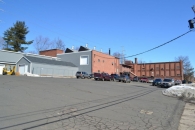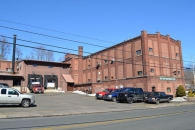Mill Record Bristol
RETURN TO ‘FIND MILLS’Disclaimer: Content for these properties was compiled in 2014-2017 from a variety of sources and is subject to change. Updates are occasionally made under Property Information, however the Connecticut Trust for Historic Preservation (dba Preservation Connecticut) makes no representation or warranty that the information is complete or up-to-date.
- Complex Name (Common)
- C.G. Garrigus Machine Co.
- Complex Name (Historic)
-
- C.G. Garrigus Machine Co.
- Address or Location
- 165 Riverside Avenue, Bristol
- County
- Hartford
- Historic Designation
- Associated Mill Community
- n/a

- Historic Information
Companies Associated w/Complex
- Bristol Technical High School 1936-1960
- C.G. Garrigus Machine Co. 1908-1917
- Harry I. Bartholomew Co. 1932-1936
- Rowley Spring Company 1960-1994
- Wallace Barnes Co. 1917-1932
Use (Historic)
Largest Documented Workforce
150 (1918)
Historic Narrative
The C.G. Garrigus Machine Company was established by prolific inventor Clarence G. Garrigus in 1907. Born in Waterbury, Connecticut, Garrigus’ mechanical inclinations saw his rise to the level of superintendant of the Tucker Manufacturing Company before the age of 20. By 1902, then 28, Garrigus was hired as mechanical superintendant of the Landers, Frary and Clark Company of New Britain, where he made significant contributions towards efforts to refine their manufacturing processes. While at Landers, Frary and Clark, Garrigus invented the Universal Breadmixer, a product he would display and demonstrate at the 1904 Worlds Fair in St. Louis, Missouri. In 1907, Garrigus moved to Bristol and organized the C.G. Garrigus Machine Company, which derived much of its early business from the Bristol Engineering Company, a firm established by Bristol industrialist Albert F. Rockwell, founder of the New Departure Company, for the production of taxis for the American Taximeter Cab Company, later known as “Yellow Cabs.” Garrigus erected a three-story brick factory on Riverside Avenue in 1908 where he also built a variety of automobile and airplane engines, many of which of his own design. The Riverside Avenue plant was expanded throughout the 1910s before the company was acquired by the Wallace Barnes Company in 1917. The factory was then converted to produce springs for machine guns. Garrigus stayed on as vice-president of the firm, and was joined by Fuller F. Barnes, president; L.D. Ames, secretary; Harry C. Barnes, treasurer; and Harold I. Arms, assistant treasurer. The Wallace Barnes Company maintained the former Garrigus factory until 1932, when it was finally closed down. The building was rented to the Harry I. Bartholomew Company, a manufacturer of metal goods, until 1936, whereupon it was donated to the City of Bristol for use as the technical department of the public high school. Students trained as machinists and mechanics on machinery and tools donated by the New Departure and E. Ingraham Companies until the program vacated the building in 1960. It them passed to the Rowley Spring Company, which occupied it until 1994. The plant currently houses a variety of small industrial firms.
- Architectural Information
Number of Existing Buildings
Roughly eight (8) primary blocks.
Dates of Construction
1908, 1910, 1912, 1916, ca. 1960, late-20th c.
Architect
n/a
Builder
n/a
Building Type
Architectural Description
The former C.G. Garrigus Machine Company plant is comprised of eight adjoining blocks forming a complex located at the northwest corner of the intersection of Riverside Avenue and Mallen Street. The earliest surviving portion of the plant is its primary factory block, this consisting of a three-story, 36’ x 140’ red brick building erected facing Riverside Avenue in 1908. The structure is of typical brick pier construction, yet shows an atypically high level of detailing. Such includes the rusticated brickwork visible on its first-story, its stone first-story watertable, tall segmental-arched window openings, stone window sills, corbelled brick cornice, concrete coping, and a corbelled brick chimney on its west elevation. The shape and profile of the cornice corbelling on the facade gives the impression of a crenellated roofline. This is emphasized by the four piers delineating the elevation’s three bays which rise above the roofline like small rectangular towers. Although the majority of the block’s window openings have been infilled, the brick used is of a lighter shade than the rest of the building, thus preserving the visual impact of the original masonry work. Numerous two-story red brick additions were erected on the west of the original block between 1910 and 1916. These are of similar detailing to the main building and were built to house additional manufacturing and utility space. Of note are a 28’ x 40’ block built as a boiler house in 1910, a second 30’ x 32’ mechanical building erected in 1912, and a 68’ x 78’ factory block built in 1916. The latter is easily identified by its sawtooth monitor roof, however, its façade has been largely reconstructed, thus obscuring its original details. A one-story, 20’ x 50’ wood-frame building located at the western edge of the plant was built for storage in 1916, yet was later used as a machine shop. The structure has a side-gabled roof and has recently been vinyl sided. The final additions to the plant came during the second half of the 20th century. These include a one- and two-story, 37’ x 67’ shipping and receiving block built at the center of the complex ca. 1960; and a two-story, 31’ x 71’ wood-frame storage building erected at the northwest corner of the plant late in the 20th century. The former has vertical board and batten siding, while the latter has recently been vinyl sided. Both have flat roofs.
Exterior Material(s)
Structural System(s)
Roof Form
Roof Material
Power Source
Condition
Fair
Condition Notes
The factory is in fair condition. The majority of the exterior walls appear to be reasonably well maintained, however, show some signs of staining and deterioration. The majority of the original wood or metal sash windows throughout the plant have been replaced or infilled.
- Property Information
-
Specific Location
One legal parcel (165 Riverside Ave.) totaling 0.99 acres at the northwest corner of the intersection of Riverside Avenue and Mallen Street.
Adjacent To
Exterior Visible from Public Road?
Yes
Parcel ID / Assessor Record Link
- 30/ / 135 / Link →
Acreage
0.99
Use (Present)
- Sources
-
Form Completed By
Lucas A. Karmazinas
Date
03/12/2015
Bibliography
- List of Connecticut Manufacturers, 1922, 1924, 1930, 1932.
- Directory of Connecticut State Manufacturers, 1936, 1939.
- Industrial Directory of Connecticut, 1947.
- Register of War Production Facilities in Connecticut, 1951.
- Map of Hartford County, H & C.T. Smith, 1855.
- Atlas of Hartford County, Beers, Baker & Tilden, 1869.
- Sanborn Map Company, 1884, 1890, 1895, 1900, 1905, 1911, 1916, 1921, 1928, 1951.
- Bristol City Directory, 1860-1960.
- Hartford Courant, 1908, 1910, 1912, 1915 1916, 1918.
- Our Yankee Heritage: The Making of Bristol, Beals, Carlton, 1954.
- Bristol, Connecticut: In the Olden Time “New Cambridge,” Which Includes Forestville, Smith, Eddy N., 1907.
- Representative View(s)Click on image to view full file







